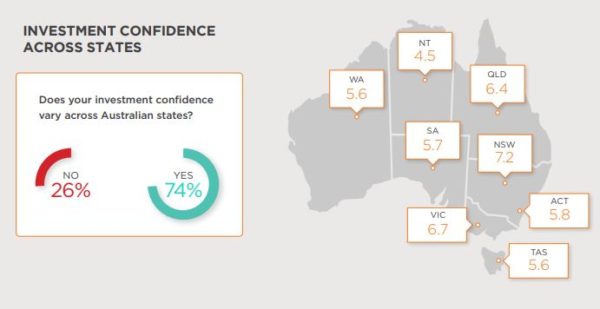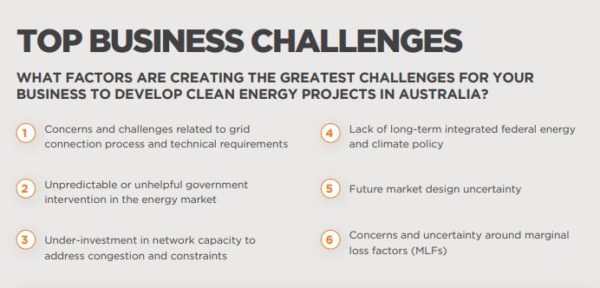A new report from the Clean Energy Council reveals that the grid connection process is the most significant challenge facing large-scale renewable energy projects in Australia, with substantial delays and changes in technical requirements impacting projects and investor confidence.
The Clean Energy Council’s (CEC) latest Clean Energy Outlook – Confidence Index also found that “unhelpful and unpredictable government intervention” has increased risk and undermined confidence for new investment in Australia’s renewable energy market.
“This is the time to be opening the doors to new investment in utility-scale clean energy projects, boosting jobs and regional development and ensuring that sufficient new generation is in place before old fossil-fuel generators retire or are priced out of the market,” CEC chief executive Kane Thornton said.
“Instead, we’ve seen governments backing two gas plants in New South Wales, the surprising decisions from the Federal Government not to support the Kaban Green Power Hub and then reject the world-leading Asian Renewable Energy Hub hydrogen project, on top of moves to change the funding remit of the Australian Renewable Energy Agency.
“It’s a concerning series of events and not a particularly welcoming environment if you’re an investor in clean energy.”
The CEC report, based on the results of a survey of Australia’s renewable energy and energy storage industry’s leaders, found that investor confidence has continued to decline in the past 12 months, dropping from 7.3 out of 10 in July 2020 to 6.3 this year, its lowest level since December 2019.

“We have in the past invested in projects that on paper seemed like a safe bet only to be frustrated by red tape, policy indecision, regulatory changes and slow decision making. We are now highly sceptical,” one respondent was quoted as saying.
The decline in investor confidence is supported by figures released by the Clean Energy Regulator (CER) which show no major large-scale renewable energy project reached financial close in the March quarter and there was a 76% reduction in the amount of renewable energy completing installation compared to the same quarter in 2020.
The regulator however indicated the pipeline of large-scale projects with a power purchase agreement, which is seen as a leading indicator, had reached a record 3.7 GW over Q1 2021, suggesting that investment in 2021 and beyond should remain strong.
The CER expects between 2 and 3 GW of large-scale renewables capacity to reach financial close in 2021, a similar level to 2020, but conceded the difficulty, time and costs in getting connection approvals may delay some projects.
The CER’s concession echoed the concerns of investors who said the challenges related to the grid connection process and technical requirements remain the greatest barriers to the rollout of renewable energy projects.
“Grid connection certainty is still the greatest dampener when it comes to investment confidence,” one industry figure wrote.
“We have capital ready to deploy and projects ready, but the grid remains the single biggest barrier to investment,” said another.

The nation’s ageing transmission infrastructure also remains a concern for investors who highlighted an under-investment in network capacity to address congestion and constraint issues.
Thornton said it is incumbent upon authorities to deliver on the Australian Energy Market Operator’s Integrated System Plan (ISP) which has identified the highest priority transmission projects with a clear business case to benefit electricity customers concerning the price, security and reliability of the energy system.
The ISP also recognised that new renewable energy projects, including wind and solar will not enter the energy mix as quickly as necessary without adequate investment in transmission infrastructure.
“These transmission projects are nation-building projects that will see us through into the next century,” Thornton said.
“Build the transmission infrastructure, and the renewable energy investors will come, benefitting the entire Australian economy, keeping the lights on, supporting low emissions technologies and delivering low-cost energy to consumers.
“Without transmission investment, congestion will increase, creating greater risks for generators and further stalling investment.”
The lack of a long-term integrated federal energy and climate policy was also an issue for investors while concerns and uncertainty around marginal loss factors (MLFs) also featured in their responses.
This content is protected by copyright and may not be reused. If you want to cooperate with us and would like to reuse some of our content, please contact: editors@pv-magazine.com.









When people/nations cannot make up their mind of their priorities… Saving Lives and Human Suffering over Asset Protection (of Fossil Fuel Plants/Infrastrucutre) that cause this… Solar or ANY OTHER Solution that benefits THE PEOPLE over the “Money Bags”… THE PEOPLE will contknue to Die and Suffer… as Politicians and Lawyers take charge and “sell their soul” to the highest bidder…. welcome Australians … THE PEOPLE of Australia… you nation is being hijacked…. 👏👏👏👏